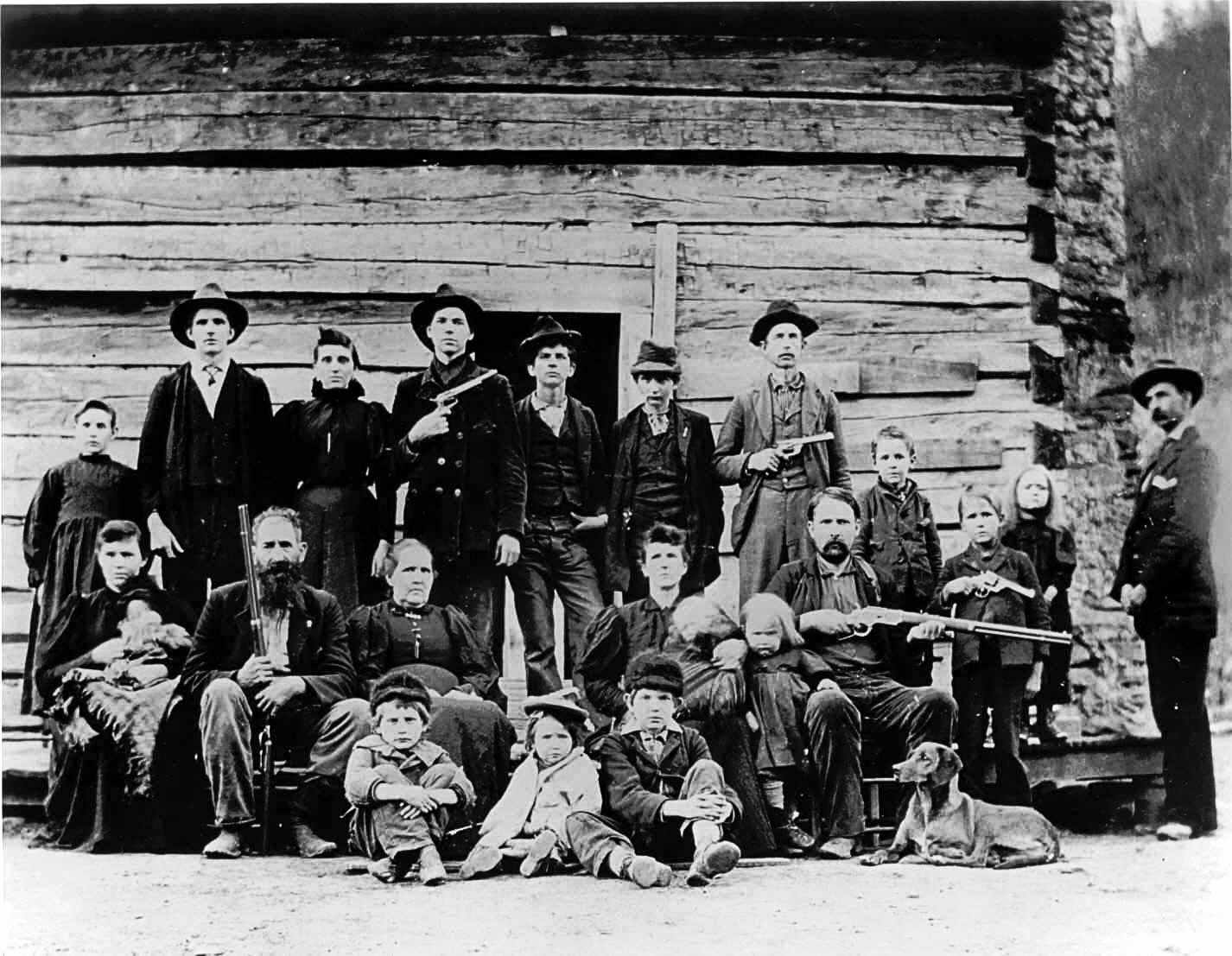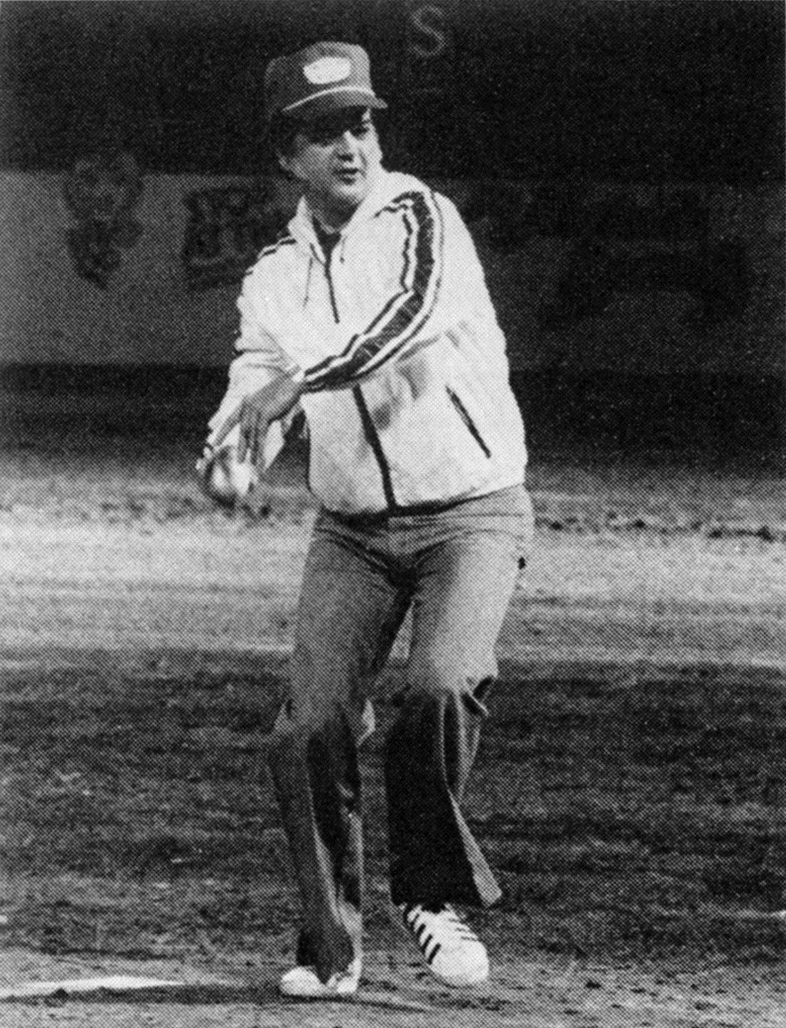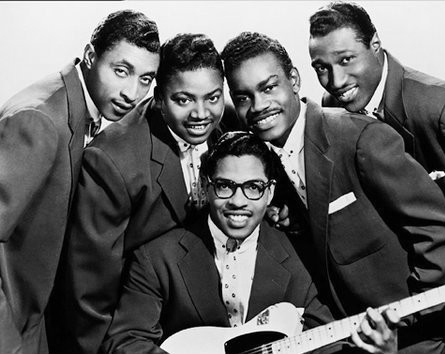|
Rockabilly (rhythm)
Rockabilly is one of the earliest styles of rock and roll music. It dates back to the early 1950s in the United States, especially the South. As a genre it blends the sound of Western musical styles such as country with that of rhythm and blues, leading to what is considered "classic" rock and roll. Some have also described it as a blend of bluegrass with rock and roll. The term "rockabilly" itself is a portmanteau of "rock" (from "rock 'n' roll") and "hillbilly", the latter a reference to the country music (often called "hillbilly music" in the 1940s and 1950s) that contributed strongly to the style. Other important influences on rockabilly include western swing, boogie-woogie, jump blues, and electric blues. Defining features of the rockabilly sound included strong rhythms, boogie woogie piano riffs, vocal twangs, doo-wop acapella singing, and common use of the tape echo; but progressive addition of different instruments and vocal harmonies led to its "dilution". Initially p ... [...More Info...] [...Related Items...] OR: [Wikipedia] [Google] [Baidu] |
Rock And Roll
Rock and roll (often written as rock & roll, rock 'n' roll, or rock 'n roll) is a Genre (music), genre of popular music that evolved in the United States during the late 1940s and early 1950s. It Origins of rock and roll, originated from African-American music such as jazz, rhythm and blues, boogie woogie, gospel music, gospel, as well as country music. While rock and roll's formative elements can be heard in blues records from the 1920s and in country records of the 1930s,Peterson, Richard A. ''Creating Country Music: Fabricating Authenticity'' (1999), p. 9, . the genre did not acquire its name until 1954. According to journalist Greg Kot, "rock and roll" refers to a style of popular music originating in the United States in the 1950s. By the mid-1960s, rock and roll had developed into "the more encompassing international style known as rock music, though the latter also continued to be known in many circles as rock and roll."Kot, Greg"Rock and roll", in the ''Encyclopædia Bri ... [...More Info...] [...Related Items...] OR: [Wikipedia] [Google] [Baidu] |
Hillbilly
Hillbilly is a term (often derogatory) for people who dwell in rural, mountainous areas in the United States, primarily in southern Appalachia and the Ozarks. The term was later used to refer to people from other rural and mountainous areas west of the Mississippi river, too, particularly those of the Rocky Mountains and near the Rio Grande. The first known instances of "hillbilly" in print were in ''The Railroad Trainmen's Journal'' (vol. ix, July 1892), an 1899 photograph of men and women in West Virginia labeled "Camp Hillbilly", and a 1900 ''New York Journal'' article containing the definition: "a Hill-Billie is a free and untrammeled white citizen of Alabama, who lives in the hills, has no means to speak of, dresses as he can, talks as he pleases, drinks whiskey when he gets it, and fires off his revolver as the fancy takes him". The stereotype is twofold in that it incorporates both positive and negative traits: "Hillbillies" are often considered independent and self-relian ... [...More Info...] [...Related Items...] OR: [Wikipedia] [Google] [Baidu] |
Conway Twitty
Harold Lloyd Jenkins (September 1, 1933 – June 5, 1993), better known by his stage name Conway Twitty, was an American singer and songwriter. Initially a part of the 1950s rockabilly scene, Twitty was best known as a country music performer. From 1971 to 1976, Twitty received a string of Country Music Association awards for duets with Loretta Lynn. He was inducted into both the Country Music and Rockabilly Halls of Fame. Twitty was known for his frequent use of romantic and sentimental themes in his songs. Due to his following being compared to a religious revival, comedian Jerry Clower nicknamed Twitty "The High Priest of Country Music", the eventual title of his 33rd studio album. Twitty achieved stardom with hit songs like " Hello Darlin'", "You've Never Been This Far Before", and " Linda on My Mind". Twitty topped '' ''Billboard'''s'' Hot Country Songs chart 40 times in his career, a record that stood for 20 years until it was broken by George Strait, and topped the '' ... [...More Info...] [...Related Items...] OR: [Wikipedia] [Google] [Baidu] |
Jerry Lee Lewis
Jerry Lee Lewis (September 29, 1935October 28, 2022) was an American singer, songwriter and pianist. Nicknamed "The Killer", he was described as "rock & roll's first great wild man". A pioneer of rock and roll and rockabilly music, Lewis made his first recordings in 1952 at Cosimo Matassa's J&M Studio in New Orleans, Louisiana, and early recordings in 1956 at Sun Records in Memphis, Tennessee. "Crazy Arms" sold 300,000 copies in the Southern United States, but it was his 1957 hit "Whole Lotta Shakin' Goin' On" that shot Lewis to worldwide fame. He followed this with the major hits "Great Balls of Fire", "Breathless (Jerry Lee Lewis song), Breathless", and "High School Confidential (Jerry Lee Lewis song), High School Confidential". His rock and roll career faltered in the wake of his marriage to Myra Gale Brown, his 13-year-old cousin once removed. His popularity quickly eroded following the scandal and with few exceptions such as a cover of Ray Charles's "What'd I Say", he did ... [...More Info...] [...Related Items...] OR: [Wikipedia] [Google] [Baidu] |
Johnny Burnette
John Joseph Burnette (March 25, 1934 – August 14, 1964) was an American singer and songwriter of rockabilly and pop music. In 1952, Johnny and his brother, Dorsey Burnette, and their mutual friend Paul Burlison formed the band that became known as the Rock and Roll Trio. His career was cut short on August 14, 1964, when he was killed in a boat crash at age 30. He is the father of 1980s rockabilly singer Rocky Burnette. Early life Johnny Burnette was born to Willie May and Dorsey Burnett Sr. in Memphis, Tennessee, United States. (The "e" at the end of his name was added later.) Johnny grew up with his parents and Dorsey Jr. in a public housing project in the Lauderdale Courts area of Memphis, which from 1948 until 1954 was also the home of Gladys and Vernon Presley and their son, Elvis. Johnny attended Blessed Sacrament School, and after graduating from eighth grade he went to Catholic High School, in Memphis. (Early press reports, dating back to 1956, stated erroneously t ... [...More Info...] [...Related Items...] OR: [Wikipedia] [Google] [Baidu] |
Elvis Presley
Elvis Aaron Presley (January 8, 1935 – August 16, 1977), or simply Elvis, was an American singer and actor. Dubbed the "Honorific nicknames in popular music, King of Rock and Roll", he is regarded as Cultural impact of Elvis Presley, one of the most significant cultural figures of the 20th century. His energized interpretations of songs and sexually provocative performance style, combined with a singularly potent mix of influences across color lines during a civil rights movement, transformative era in race relations, led him to both great success and Cultural impact of Elvis Presley#Danger to American culture, initial controversy. Presley was born in Tupelo, Mississippi, and relocated to Memphis, Tennessee, with his family when he was 13 years old. His music career began there in 1954, recording at Sun Records with producer Sam Phillips, who wanted to bring the sound of African-American music to a wider audience. Presley, on rhythm acoustic guitar, and accompanied by lead ... [...More Info...] [...Related Items...] OR: [Wikipedia] [Google] [Baidu] |
Carl Perkins
Carl Lee Perkins (April 9, 1932 – January 19, 1998)#nytimesobit, Pareles. was an American guitarist, singer and songwriter. A rockabilly great and pioneer of rock and roll, he began his recording career at the Sun Studio, in Memphis, Tennessee, Memphis, beginning in 1954. Among his best-known songs are "Blue Suede Shoes", "Honey Don't", "Matchbox (song), Matchbox" and "Everybody's Trying to Be My Baby". According to fellow musician Charlie Daniels, "Carl Perkins' songs personified the rockabilly era, and Carl Perkins' sound personifies the rockabilly sound more so than anybody involved in it, because he never changed."#legends, Naylor, p. 118. Perkins's songs were recorded by artists (and friends) as influential as Elvis Presley, the Beatles, Jimi Hendrix, Johnny Cash and Eric Clapton, which further established his prominent place in the history of popular music. Paul McCartney said "if there were no Carl Perkins, there would be no Beatles." Nicknamed the "Honorific nicknam ... [...More Info...] [...Related Items...] OR: [Wikipedia] [Google] [Baidu] |
Tape Echo
Delay is an audio signal processing technique that records an input signal to a storage medium and then plays it back after a period of time. When the delayed playback is mixed with the live audio, it creates an echo-like effect, whereby the original audio is heard followed by the delayed audio. The delayed signal may be played back multiple times, or fed back into the recording, to create the sound of a repeating, decaying echo. Delay effects range from a subtle echo effect to a pronounced blending of previous sounds with new sounds. Delay effects can be created using tape loops, an approach developed in the 1940s and 1950s and used by artists including Elvis Presley and Buddy Holly. Analog effects units were introduced in the 1970s; digital effects pedals in 1984; and audio plug-in software in the 2000s. History The first delay effects were achieved using tape loops improvised on reel-to-reel audio tape recording systems. By shortening or lengthening the loop of tape and adj ... [...More Info...] [...Related Items...] OR: [Wikipedia] [Google] [Baidu] |
Doo-wop
Doo-wop (also spelled doowop and doo wop) is a genre of rhythm and blues music that originated in African-American communities during the 1940s, mainly in the large cities of the United States, including New York, Philadelphia, Pittsburgh, Chicago, Baltimore, Newark, Detroit, Washington, DC, and Los Angeles. It features vocal group harmony that carries an engaging melodic line to a simple beat with little or no instrumentation. Lyrics are simple, usually about love, sung by a lead vocal over background vocals, and often featuring, in the bridge, a melodramatically heartfelt recitative addressed to the beloved. Harmonic singing of nonsense syllables (such as "doo-wop") is a common characteristic of these songs. Gaining popularity in the 1950s, doo-wop was "artistically and commercially viable" until the early 1960s, but continued to influence performers in other genres.Hoffmann, FRoots of Rock: Doo-Wop In ''Survey of American Popular Music'', modified for the web by Robert Birklin ... [...More Info...] [...Related Items...] OR: [Wikipedia] [Google] [Baidu] |
Twang
Twang is an onomatopoeia originally used to describe the sound of a vibrating bow string after the arrow is released.Hensleigh Wedgwood, ''A Dictionary of English Etymology: Q - Z'' (1865), p. 433. By extension it applies to the similar vibration produced when the string of a musical instrument is plucked, and similar sounds. The term came to be applied to a nasal vocal resonation, and was historically used to describe "a disagreeable resonance". Later, however, the term came to be more broadly associated with regional dialects, to the extent that in some locations, "a twang is a desirable commodity".Jim Tushinski, Jim Van Buskirk, ''Identity Envy Wanting to Be Who We're Not: Creative Nonfiction by Queer Writers'' (2014), p. 27. Specific uses of the term include: * A particular sharp vibrating sound characteristic of some electric guitars. * A high frequency singing sound especially affected by country singers. It allows for a higher vocal reach than would be possible using th ... [...More Info...] [...Related Items...] OR: [Wikipedia] [Google] [Baidu] |
Boogie Woogie
Boogie-woogie is a genre of blues music that became popular during the late 1920s, developed in African-American communities since 1870s.Paul, Elliot, ''That Crazy American Music'' (1957), Chapter 10, p. 229. It was eventually extended from piano, to piano duo and trio, guitar, big band, country and western music, and gospel. While standard blues traditionally expresses a variety of emotions, boogie-woogie is mainly associated with dancing (although not the competitive dance known as boogie-woogie, a term of convenience in that sport). The genre had a significant influence on rhythm and blues and rock and roll. Musical features Boogie-woogie is characterized by a regular left-hand bass figure, which is transposed following the chord changes. : : Boogie-woogie is not strictly a solo piano style; it can accompany singers and be featured in orchestras and small combos. It is sometimes called ''"eight to the bar"'', as much of it is written in common time () time using eighth note ... [...More Info...] [...Related Items...] OR: [Wikipedia] [Google] [Baidu] |
Electric Blues
Electric blues refers to any type of blues music distinguished by the use of electric amplifier, amplification for musical instruments. The guitar was the first instrument to be popularly amplified and used by early pioneers T-Bone Walker in the late 1930s and John Lee Hooker and Muddy Waters in the 1940s. Their styles developed into West Coast blues, Detroit blues, and post-World War II Chicago blues, which differed from earlier, predominantly acoustic-style blues. By the early 1950s, Little Walter was a featured soloist on Richter-tuned harmonica, blues harmonica using a small hand-held microphone fed into a guitar amplifier. Although it took a little longer, the electric bass guitar gradually replaced the stand-up bass by the early 1960s. Electric organs and especially keyboards later became widely used in electric blues. Early regional styles The blues, like jazz, probably began to be amplified in the late 1930s.V. Bogdanov, C. Woodstra, S. T. Erlewine, ''All music guide ... [...More Info...] [...Related Items...] OR: [Wikipedia] [Google] [Baidu] |




.jpg)



